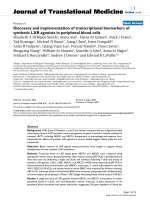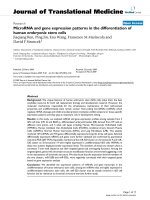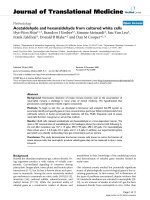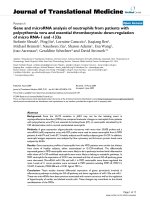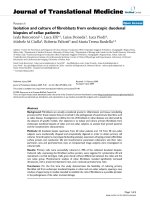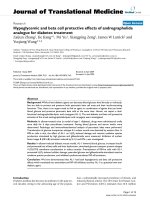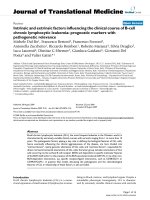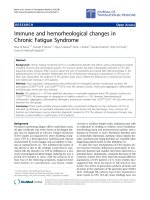báo cáo hóa học:" Gender and sexuality: emerging perspectives from the heterosexual epidemic in South Africa and implications for HIV risk and prevention" pdf
Bạn đang xem bản rút gọn của tài liệu. Xem và tải ngay bản đầy đủ của tài liệu tại đây (272.26 KB, 11 trang )
COM M E N T ARY Open Access
Gender and sexuality: emerging perspectives
from the heterosexual epidemic in South Africa
and implications for HIV risk and prevention
Rachel Jewkes
1*
, Robert Morrell
2
Abstract
Research shows that gender power inequity in relationships and intimate partner violence places women at
enhanced risk of HIV infection. Men who have been violent towards their partners are more likely to have HIV.
Men’s behaviours show a clustering of violent and risky sexual practices, suggesting important connections. This
paper draws on Raewyn Connell’s notion of hegemonic masculinity and reflections on emphasized femininities to
argue that these sexual, and male violent, practices are rooted in and flow from cultural ideals of gender identities.
The latter enables us to understand why men and women behave as they do, and the emotional and material
context within which sexual behaviours are enacted.
In South Africa, while gender identities show diversity, the dominant ideal of black African manhood emphasizes
toughness, strength and expression of prodigious sexual success. It is a masculinity women desire; yet it is sexually
risky and a barrier to men engaging with HIV treatment. Hegemonically masculine men are expected to be in con-
trol of women, and violence may be used to establish this control. Instead of resisting this, the dominant ideal of
femininity embraces compliance and tolerance of violent and hurtful behaviour, including infidelity.
The women partners of hegemonically masculine men are at risk of HIV because they lack control of the circum-
stances of sex during particularly risky encounters. They often present their acquiescence to their partners’ beha-
viour as a trade off made to secure social or material rewards, for this ideal of femininity is upheld, not by violence
per se, by a cultural system of sanctions and rewards. Thus, men and women who adopt these gender identities
are following ideals with deep roots in social and cultural processes, and thus, they are models of behaviour that
may be hard for individuals to critique and in which to exercise choice. Women who are materially and emotion-
ally vulnerable are least able to risk experiencing sanctions or foregoing these rewards and thus are most vulner-
able to their men folk.
We argue that the goals of HIV prevention and optimizing of care can best be achieved through change in gender
identities, rather than through a focus on individual sexual behaviours.
Introduction
Intersections of HIV, gender power inequity in
relationships and violence: evidence from epidemiology
In countries of sub-Saharan Africa with a predominantly
heterosexual HIV epidemic, the prevalence in women
climbs steeply in the late teens, which is five years
before this occurs in men. Overall, a much greater pro-
portion o f the adult female population become infected
[1,2]. Understanding this difference between women and
men is critical for HIV prevention. While there are sex
differences in susceptibility to HIV, which, like all sex
differences, are rooted in biology [3], the patterns of
prevalence have more com plex origins. It is not biology,
but gender differences in sexual socialization t hat are
more important in influencing who women and men
partner, when and in which circumstances.
Key here are differences in the way in which men and
women position themselves and act as socia l beings, i.e.,
differences in socially defined and constructed ways of
being a man or woman, and the power and possibi lities
so entai led. For it is gender, not sex, that is more influ-
ential in determining behaviour. In a given relationship,
* Correspondence:
1
Gender & Health Research Unit, Medical Research Council, Private Bag
X3985, Pretoria 0001 South Africa
Jewkes and Morrell Journal of the International AIDS Society 2010, 13:6
/>© 2010 Jewkes and Morrell; licensee BioMed Central Ltd. This is an Open Access article distributed under the terms of the Creative
Commons Attribution License ( which permits u nrestricted use, distribution, and
reproduction in any medium, provided the original work is properly cited.
for example, a man may expect to lead and control sex-
ual relations and his woman partner to comply, and he
may feel entitled to have sex with other women, but
expect her to remain faithful. Gender differences take
many different forms in different settings, but an area of
commonality lies i n diffentials in power. There is strong
evidence that gender power inequity in relationships,
which is a cause of intimate partner violence, places
women at enhanced risk of HIV infection.
South Africa is a country which exemplifies the dual
epidemics of HIV and gender-based violence. It pre-
sently has 5.5 million people living with HIV, out of a
population of about 47 million [1], the largest HIV epi-
demic in the world. The society is strongly patriarchal,
and violence against women is widespread. South Afri-
ca’s rate of rape has been found to be the hig hest of any
INTERPOL member country [4], with more than 55,000
rapes reported to the police annually [5].
Intimate partner violence is also c ommon. Research
has found that between 25% and 55% of women h ave
experienced physical intimate partner violence [6-8],
and the rate of female homicide by an intimate partner
is six times the global average [9]. In interviews, 42% of
men disclose perpetration of intimate partner violence
[10,11] and 28% disclose rape of a woman or girl [10].
These two epi demics have provided an important
impetus for research into the nexus of gender and HIV,
and the country provides an i mportant opportunity to
understand these problems and the implications of them
for responses to HIV.
A decade of cross-sectional research from African
countries, including Rwanda, Tanzania, South Africa
and more recently, India, has consistently found women
who have experienced partner violence to be more likely
to be infected with HIV [12-15]. Two studies have
shown that women who have been sexually coerced b y
male partners in Rwanda (n = 914) and Tanzania (n =
245) had a higher prevalence of HIV, with a n adjusted
odds ratio (aOR) of 1.89 (1.20, 2.96) in Rwanda, and
2.39 (1.21, 4.73) in Tanzania [12,13]. The Tanzanian
study was conducted among wom en in a clinic offering
voluntary testing and counselling, and it also showed
that those aged under 30 who had ev er experienced
physical intimate partner violence were significantly
more likely to have HIV [13].
In South Africa, amon g wom en (n = 1366) in antena-
tal care having HIV testing as part of treatment for pre-
vention of mother to child transmission, those
experiencing the greatest gender power inequity in rela-
tionships when compared with the most power equitable
of three categories [aOR 1.56 (1.15, 2.11)], as well as
those experiencing physical or sexual violence [aOR 1.53
(1.10, 2.04)] were more likely to be HIV seropositive
[14]. Emerging evidence from yet unpublished
longitudinal data from South Africa shows that women
who have experienced intimate partner violence and
have greater gender power inequity in relationships are
at elevated risk of acquiring HIV. In both cases, there is
a dose response relationship [16].
Research from India, analyzing data from husband-
wife dyads (n = 20,425) that provided both intimate
partner violence (IPV) exposure and HIV sero status has
shown that abused wives face increased HIV risk, based
both on the greater likelihood of HIV infection among
abusive husbands and elevated HIV transmission within
abusive relationships. This suggests that I PV functions
both as a risk marker and as a risk factor for HIV
among women [15].
In an effort to explain why partner violence and rela-
tionship gender power inequity should place women at
risk of HIV, research has been conducted with men.
This has shown that like their Indian counterparts,
South African men who have been physically violent
towards partners are more likely to be infected with
HIV [10,15]. Some indications of why men who have
been violent are more likely to be H IV infected can be
seen in analyses that focus on the inter-relationship of
gender-based violence perpetration and a range of risky
sexual practices.
South African research shows an apparent clustering
of violent, anti-soci al and risky sexual practices, suggest-
ing that these are connected. Thus, men who have been
violent towards intimate partners are more likely to
rape, have large numbers of part ners, drink heavily, not
use condoms, have sex with prostitutes and engage in
transactional sex [17]. Men who rape are more likely to
have had transactional sex, be physica lly violent to part-
ners, have l arge numbers of partners, drink heavily and
engage in transactional sex [18]. Men who engage in
transactional sex are more likely to be physically violent
to partners, have large number of partners, drink heavily
and rape [19]. In essence, men who are violent are more
likely to be sexually risky, and vice versa. A key question
is: what is the basis and nature of this connection? And
what are the implications of these for HIV risk, preven-
tion and care?
This paper seeks to move beyond the epidemiology
and the measurement of behaviours and associations
and enable us to understand these empirical findings. In
so doing, we draw on theoretical resources from the
area of critical men’ s studies, and in particular, the
notion of hegemonic masculinity , initially developed and
expounded by Raewyn Connell [20,21], and related dis-
cussion of femininities. We will describe the theoretical
framework, discuss its relevance in terms of findings of
South African research on hegemonic masculinity and
femininities and their relation to HIV risk, and relate it
to broader concerns in HIV prevention and care.
Jewkes and Morrell Journal of the International AIDS Society 2010, 13:6
/>Page 2 of 11
Theoretical perspectives on men and gender
Feminist studies of sex and gender have historically
foregrounded the oppression of women. Debates about
the causes of, particularly, sexual oppression have fre-
quently invoked a nature/nurture binary to explain glo-
bal patterns of men’ s dominance over women. The
former approach, which focuses on the genetic or physi-
cal to explain gender inequalities, has the major disad-
vantages of failing to explain diversity among men and
among women and of lackin g a mode l of how to make
things better. Models that focus on how gender is a
learned behaviour make more allowance for diversity
and provide conceptual clarity about the forms that
inequality take and how inequalities occur. Such analysis
also can suggest gender equity interventions.
The f ocus on the social construction of gender has in
the past quarter of a century generated a sophisticated
literature on the gender identities of men and women,
masculinities and femininities. This has permitted the
conc eptual inclusion of men within the ambit of gender
studies, an initiative strongly associated with the theore-
tical work of Raewyn Connell [20,21].
Connell [20,21] describes the existence of multiple
configurations of masculinity that are hierarchically
organized and structured along lines of gendered domi-
nation (of men over women, of powerful men over less
powerful men, of adult men over younger men). She
identifies one masculine position that is dominant and
refers to this as “hegemonic masculinity” .Itisthisposi-
tion that is generally associated with the subordination
and oppression of women.
The concept of hegemony, drawn from Antonio
Gramsci’s work, refers to the exercise of power by creat-
ing consent through the establishment of accepted ideas
or values. The concept is generally used descriptively to
identify that form of ma sculinity that legitimates the
subordination of women. It is in this sense that the fra-
mework enables an analysis of gende r power while also
allowing for the existence of divergent forms of male
expression that may, for example, challenge the unques-
tioned right of men to this power.
There have been several interpretations of hegemonic
masculinity by Connell herself [22] and others. Some
focus on the fluidity and contested nature of the concept,
while others stress the organizing, structured and structur-
ing nature of hegemony. In this latter sense, hegemonic
masculinity represents the dominant cultural model of
idealized manhood. It is a frame used by individual men to
judge their “success” as men. In a highly gender-inequita-
ble country like South Africa, hegemonic masculinity
mobilizes and legitimates the subordination and control of
women by men. Conceived in this way, hegemonic mascu-
linity is a necessary and integral element of patriarchy, the
social organ ization that allocates, distributes and secures
the power of men over women.
Hegemonic masculinity is characterized by a se t of
practices that both expresses men’s power within the
social system and serves to bolster this power. In
essence, the practices flow from the hegemonic ideal.
Implicit in the idea of “hegemony ” is recognition that
social ascendancy of this ideal of masculinity is not
achieved through brute force, although viol ence may be
used by men to bolster this ideal, but through a com-
plex web of processes that extend into the organization
of private life and cultural arrangements [21]. Thus,
tenets of culture and religion and, for example, the
operation of the legal system, may work to preserve the
ascendancy of a particular cultural ideal of manhood.
Connell [21] argues that there is no equivalent notion
of “hegemonic femininity” because there is more diver-
sity in feminine ideals, although women are globally
subordinate d to men. She describes a form, or forms, of
“emphasized femininity” that is characterized by compli-
ance with women’s subordination and an orientation
towards accommodating the interests and desires of
men. In other words, women “agree” with the unequal
structurin g of relations, do not challenge these relations,
and ultimately collude in the unequal distribution of
gender power with men. Other forms of femininity are
shaped around strategies of resistance, and some com-
bine compliance, resistance and cooperation [21].
Just as hegemonic masculinity is given power as a
“cultural norm”, forms of femininity that either in whole
or in part emphasize compliance with this are expressed
as cultural ideals of femininity, and are usually in some
way socially rewarded. Women who adopt femininities
based on resistance, or indeed engage in acts of resis-
tance, can be marginalized and stigmatized. Patriarchal
societies are heteronormative, that is, they require men
and women to demonstrate their gender by actively par-
ticipating in heterosex or affirming heterosexual d esire
[23].
While there are societally different ways in which this
might be done, transgressions of heteronormativity are
punished, and in South Africa, often violently so. The
gang rape of African lesbian women and other instances
of homophobic violence are particularly horrifying
examples of this [24,25]. Having said this, it is important
to note that gender identities change over time and that
under particular circumstances, may change rapidly, for
example, when legal or material contexts change drama-
tically. In South Africa, there is evidence that gender
identities are indeed changing, although for our pur-
poses, the persistence of gender violence remains a wor-
rying continuity that shapes and binds forms of
femininity and masculinity.
Jewkes and Morrell Journal of the International AIDS Society 2010, 13:6
/>Page 3 of 11
While hegemonic masculinity, and emphasized femi-
ninity, encompass practices that extend far beyond the
arena of domestic, sexual and otherwise intimate rela-
tions with women (and men), it is the expression of
these practice s in t hese domains that is particularly per-
tinent to consideration of the intersections of gender
power inequity and intimate partner violence and HIV
risk. A lens of gender iden tity provides a frame through
which we can begin to understand why men and
women behave in the way that they d o. It provides a
way of reflecting on the emotional and material context
within which sexual behavio urs are enacted, in p articu-
lar, the broad er struggl es, aspirations, desires and needs
that motivate men and women’s behaviour. It follows
that only when we understand this, will we be able to
change sexual behaviours (and thereby reduce the risk
of HIV infection).
Shape of masculinities and femininities among black
Africans in South Africa
The gender order in South Africa under colonialism and
apartheid was strongly racialized [26]. Two major fea-
tures are relevant here. The first is that racial integration
occurred to a very limited extent and this ensured that
black African and white South Africans lived largely
separate lives, connecting i n the work place under con-
ditions of inequality (whites dominating professional
and business positions, and black Africans overwhel-
mingly limited to positions as labourers or subsistence
farmers). Thi s arrangement allowed for quite distinct
racialized gender arrangements to persist, with perhaps
the most notable feature being the retention of tradi-
tional forms of (male-dominated) authority (for example,
chiefs). The second important feature was the emer-
gence of distinctive gendered ideals for black and white
men and women.
The material inequalities and associated spatial demo-
graphy (with black Africans prohibited for a long period
from living in cities unless in the service of white-owned
industry, and therefore confined to increasingly impo-
verished rural areas), which are a feature of South Afri-
can life t o this day, impacted on constructions of
masculinity and femininity. Offering a broad brush
stroke description of gender topography always runs
risks, but for our purposes, we will venture some gener-
alizations. We do so even as we acknowledge that the
changes unleashed by national political developments
(especially the assumption of power by the African
National Congress in 1994) and global economic forces
have effected significant alterations to the stark pic ture
that we paint here.
Until 1994, white men and women had the vote, had
ready access to economic power or, at least, stable
employment, and to forms of social and public status
[26]. This influenced the ideals to which both white
men and women aspired. White men were heavily
invested in material achiev ement, public position and
embodiment that found particular expression in sporting
achievement. White women, on the other hand, were
less vested in professional autonomy, even though they
benefitted from free schooling in well-resourced institu-
tions. Their identities were primarily built around chil-
dren and the home.
For black African men and women, the material chal-
lenges of life were dominant. Men were generally
employed in menial, poorly paid positions, and many
found only seasonal, insecure ways of securing a liveli-
hood or spent much o f their time without any form of
paid work [26]. This has made it difficult for the major-
ity of black African men to vest their masculinity in
material or professional achievement, and has increased
the likelihood of finding masculine affirmation in homo-
social (sometimes criminal) settings and in their rela-
tions with black women. Black African women,
generallywithoutthemeansto be economically inde-
pendent, have often been dependent on black African
men and this, together with cultural practices of respect,
has promoted obedience and passivity as hallmarks of
African femininity. With South Africa’ shistoryofcolo-
nialism and apartheid, all gender identities are in some
ways marked by violence. We return to this theme
shortly.
Historical perspectives on sex in South Africa reveal
two competing discourses on sexuality. In one, rooted in
Christianity, sex is located in marriage for procreation.
The other reflects traditional black African ideas that
sex is a normal and healthy and an essential feature of
life for all ages, and something about which there should
be openness and communication [26]. This latter dis-
course normalizes sex play in childhood and presents
sexual exploration as a natural activity, including during
adolescence. Historically, pre-marital penetrative sex was
prohibited, but it is now the norm and, indeed, half of
all black women have had a child by the age of 21,
mostly outside marriage [27]. Within the frame of sexual
openness, African women are constructed as sexual
beings and sex is seen not just as normal in relation-
ships, but as essen tial for their success [27,28]. Further-
more, in th e doma in of healing, sex i s seen as a process
of cleaning, and is commonly advised by traditional hea-
lers (and nurses) for a range of maladies [29].
For our purposes, it is impor tant to make some state-
ments specifically about gender in South Africa s ince
1994, when the country formally entered a period of
transition, dismantling apartheid’s edifice and construct-
ing a new legal and policy framework for a non-racial
democracy. This period has seen greater public diversity
and fluidi ty in gender identities. The most obvious
Jewkes and Morrell Journal of the International AIDS Society 2010, 13:6
/>Page 4 of 11
indication of this is the emergenceofapublicgay
movement in the wake of the constitutional protection
afforded to sexual orientation in the Bill of Rights in the
Constitution in 1996, alth ough the gay movement per se
long preceded this [30].
For women, there has been a conspicuous emergence,
primarily in urban settings, of “modern girl” femininities,
associated with the exercise of independence, the use of
specific fashion commodities and “explicit eroticism”
[31]. This is an ideal of womanhood that is chiefly t he
domain of those women with access to (at least some)
material resources. Whether these girls and young
women seek political emancipation, or economic or sex-
ual independence, the emergence of this phenomenon
has drawn attention to the question of feminine agency.
Despite this diversity, there are clear patterns of power
and dominance. While there is not one, single, domi-
nant masculine form t hat serves as a model for all men,
it is empirically clear that various racialized forms of
masculinity are dominant. It is these masculinities that
prescribe particular ways of being a man and legitimate
gender-inequitable practices. One example of a black
African hegemonic masculinity is found in the Zulu
concept of isoka, an idealized heterosexual, virile man,
who is desired by women, and whose prodigious sexual
successes are the envy of other men [32]. Ethnographic
research in the Eastern Cape province has shown that a
key element of successful African manhood is heterosex-
ual success and this is proved by being able to “win”
desirable women, keep them (and thus prevent them
from being seduced by others), and show evidence of
being a man in control (of others) [33].
While the power of men is by no means established
through the use of force, indeed the cultural foundations
of patriarchy and processes through which it is main-
tained are broad and deep, and the use of violence,
within limits and in particular contexts, is viewed by
many, but not all, men as legitimate in pursuit of their
goals [34]. This applies both in the public (for example,
men resolving differences between one another using
physical violence [35]) and private domains (where
domestic violence, including femicide, is common).
South African masculinities all valorize the martial
attributes of physical strength,courage,toughnessand
an acceptance of hierarchical authority, but most of all,
they demand that men are able to exercise control (over
women and other men) [36]. Within relationships with
women, the expectati ons of establishi ng control provide
space for the use of physical and sexual violence against
women, in efforts both to achieve this and to demon-
strate it. While men are not expected to injure women,
and acts of extreme cruelty often incur familial and
community wrat h [34], the use of moderate violence by
men (and in other circumstances, by women) is
toleratedandgenerallyisnotviewedasevidenceof
weakness or lack of self-control.
With sex viewed as a need, particularly of men, but
within context, also of women, wooing women with
gifts, or exchanging money or other services for sex are
seen as largely culturally acceptable practices [19]. His-
torically, sexual relationships between individuals were
part of (subsumed) socially negotiated relationships
between families, with marriages formalized through
payment by men of lobola, the b ridew ealt h. Nowadays,
marriage occurs relatively late in adult life (at a mean
age of 28 years for women [27]), if at all, and sex mostly
happens outside marriage, and “ serious” intent is
demonstrated by gift giving. In this cultural milieu, it is
easy for men to assume some form of patriarchal own-
ership over women and to establish or demonstrate this
with physical violence. In this way, hegemonic masculi-
nity inextricably links having multiple sexual partners
with the subordination of women to male control, if
necessary with the use of violence.
Other practices which flow from hegemonic masculi-
nity involve sexual and other forms of risk taking. These
include driving cars fast and dangerously, and heavy
alcohol consumption; indeed, social norms around alco-
hol drinking are such that South Africa has the highest
level of consumption per drinker of any country in the
world [26,37]. Derision is cast on those who “fail” in
navigating these risks without losing control or showing
weakness, whether shown by their lives being destroyed
by alcoholism or by becoming infected with HIV. Thus,
blame is framed in terms of individual weakness, rather
than being placed on t he overar ching gender order that
provided the contex t within whic h these prac tices were
and are encouraged [38,39].
In this way, hegemonic masculinity can be seen as a
cultural ideal that links r isky sexual practices and the
use of violence and other controlling behaviour s against
women, particularly women partners. It is masculine-
gendered identities, and the processes through which
they are constructed, enact ed and reproduced, t hat
explain the clustering of violence and risky sexual prac-
tices seen in the epidemiological studies (discussed
above). Viewed through this lens, these practices are
seen as having meaning that extends well beyond the
motives and rewards of the individual act.
With young black African women in the forefront of
the HIV epidemic in South Africa, it is appropriate that
we apply ourselves in the same way to young black Afri-
can femininities. Our understanding of women’ssexual-
ity can be considerably advanced by reflecting in a
similar manner on gender identity and the entailed
meaning of practices. Emergin g, yet unpublished
research by the authors, based on extended qualitative
interviews and participant observation over 10 months
Jewkes and Morrell Journal of the International AIDS Society 2010, 13:6
/>Page 5 of 11
with women from the Eastern Cape, shows that the
dominant idea of successful young womanhood is one
where success is proven through being desirable to men.
This is clearly complicit with hegemonic masculinity as
it is framed in a way tha t encourages resonance , rather
than discordance, with those ideas.
With worth of women assessed by m en, women who
wish to be “successful” areundermassivepressureto
conform to the dominant social order, including accept-
ing the control by men. But there are other powerful
forces at play. In a resource-poor setting, flirting and
meeting with boyfriends provides hours of affordabl e
entertainment. Thus, women have fun, compete and
measure their desirability through flirting and encoura-
ging proposals f rom men, while remembering that this
is ultimately “proven” through having a boyfriend. Given
the threat of being single to social status and self-
esteem, and the risk of boredom, many women prefer to
have more than one boyfriend (referred to as “walking
on two legs” )lesttheysplitwithoneofthem.The
terms in Sotho and isiXhosa of nyatsi and khwapheni
refer to secret concurrent partners, which is culturally
accepted for women, as well as men, providing relation -
ships are conducted in a manner respectful of the main
partner, i.e., covertly [14,40].
With sex viewed as “natural”, women’s sexual desire is
acknowledged, as is an expectation that sex should be
pleasurable, preferably “flesh-to-flesh ” sex and thus with
no condom use [41]. While there has been a suggestion
in literature on sexuality that it is a male requiremen t,
authors have also found that women of ten oppose con-
dom use because of concerns about their sexual plea-
sure, as well as a lingering suspicion that their chances
of keeping their partners in the competitive world of
multiple concurrency, are greater with flesh-to-flesh sex
[41]. The emphasis on the heterosexual prerogative of
men in a context of great gender inequalities has often
led to treating women as sexually passive, simply waiting
for men to propose and then acquiescing [42]. In some
contrast to this, having multiple partners is on one l evel
an expression of resistance to dependence on, and even
control by, one man; yet the cultural acceptability of the
practice allows women to do so without perceiving
themselves as engaging in resistance to the gender order
as a whole.
While the dominant ideal of femininity i s fundamen-
tally subordinate, women do not all experience control-
ling behaviour by their male partners to the same
extent. Archetypically controlling boyfriends, however,
expect to know where their partners are at all times,
stop them seeing other men, expect to find them at
home when they call, and to have them willing to free
themselves from whatever they are engaged in and be
ready for sex on demand [33]. It is hardly surprising
that women with violent and contro lling partners have
been shown both to have more frequent sex and to use
condoms less often [8,43-45]. Women are expected to
avoid behaving in a way that threatens men’ssenseof
control, failing which they are expected to endure and
accept their physical punishment [33].
For African women, excusing male behaviour is an
integral part of d ominant femininity and essential for
keeping the right man. In a practical sense that entails
tolerance of violence (if he is violent), to lerance of his
other partners (or when this fails, direction of aggression
against them, rather than him), and e nsuring that sex
with the right man is “the best” (i.e. , no condoms). This
is supported by cultural wisdom, such as the saying that
“beating is a sign of love”. This dominant form of femi-
ninity thus requires women to be strong, and able to
accept and cope with the stresses life brings, including
those caused by women’s subordinate position in their
relationships.
Acquiescent femininity and hegemonic masculinity are
both cultural ideals and are upheld by a system of sanc-
tions and rewards. Women who do not comply, or
express resistance, suffer marginalization and stigmatiza-
tion. For example, divorce is an ultimate act of non-
compliance, and for women in African culture, is
strongly stigmatized and happens infrequently. In 2007,
more white South Africans divorced than Africans (9935
versus 9055), despite the fact that the former represent
only 9% of the population, compared to the latter
group’ s 80% [46]. The position of these women was
recently described by one older Xhosa woman politician,
when she said, “In our language [isiXhosa] we have iin-
tombi (unmarried girls) and iintombazana (marr ied
women). We have no word for women who divorce, we
do not know where to put them.” [47]
This is not to say that there is no social space in
South Africa for gender difference. There are many men
from across the social spectrum who adopt masculinities
that incorporate counter hegemonic practices, such as
engagement in childcare and caring for sick and dis-
abled relatives, or support for gender equality and oppo-
sition to against violence against women [48,49]. There
are also many women who are single mothers and eco-
nomically independen t of men [27]. But equally, it is
important to read these behaviours through a historical
and cultural lens.
In South Africa, the gendered division of labour has
constantly evolved and shifted. Women historically have
engaged in domestic work and caring [50]. The y have
adopted gender positions as “wives” in single-sex institu-
tional settings [51-53], and women have run households
that are economically independent of men [54]. The
long historical trajectory shows the dynamism and fluid-
ity of gender relations, but it does not show that these
Jewkes and Morrell Journal of the International AIDS Society 2010, 13:6
/>Page 6 of 11
women and men resist the fundamental gender order
that subordinates women to men [48]. It is possible to
occupy apparently dissident gender positions without
mounting an outright challenge to the gender order or
supporting an alternative, gender-equitable vision of
society.
Compliance with the dominant acquiescent femininity
is rewarded, not just by men, but by other women.
Women with desirable partners are admired by their
peers, and respected in families and communities. Just
as hegemonically masculine men seek amenable female
partners so that their relationships can be relativel y har-
monious, rather than characterized by strong resistance,
successful women desire hegemonic men [55]. Viewed
as “real men”, their displays of hegemonic masculinity
are interpreted by many women as sexually and socially
desirable, and research by the authors, and others,
shows that men who practice more gender-equitable
masculinities are often marginalized by women.
Discussion
It is important for this argument not to be read in a way
that is either culturally deterministic or victim blaming.
We argue that in pursuit of hegemonic masculinity, as
well as the dominant emphasised femininity, men and
women are following ideals that have deep cultural
roots and thus, models of behaviour that may be hard
for individuals to critique and exercise real choices
around. Indeed, we invoke a notion of choice for
women with considerable caution, given the huge con-
straints on the power of young, impoverished women in
a patriarchal society that has a marked age hierarchy.
Nonetheless, there is considerable diversity in the
actual practices of men, choices of partners by women,
and degrees of complicity, cooperation and resistance.
There are women from across the social spectrum who
resist gender inequality, and there is a proud history of
women’s movements in South Africa and of role models
of women who have asserted considerable power of dif-
ferent forms wit hin communities [56,57]. When inter-
preting women’ s decision making around partners and
responses to male violence and controlling practices, it
is apparent that women differ in the degree to which
they accept and excuse these. While in some cases, this
is a product of social and financial circumstances that
leave no options, the visibility of this in the dating rela-
tionships of girls who are supported financially in their
families reveals that the picture is more complex.
Women who experience more marked gender inequity
in relationships and violence are placed at risk of HIV
because they lack control of the circumstances of sex
during particularly risky encounters, but t heir exposure
to such gender inequity and v iolence is often related to
complicity with an ideal of hegemonic masculinity.
When women are acquiescent and accept male control
and violence, their behaviour is considered as a trade off
made from an expectation of social (or financial) reward.
The degree to which women feel able to r isk loss (or
non-acquisition) of these r ewards differs according to
other dimensions of their material and emotional vul-
nerability. Thus, the poorest and most marginalized
women, and those who have been rendered vulnerable
in other ways, such as by abuse in childhood, may be
least able to take the risk of displaying signs of non-con-
formity and resistance and of bucking the patriarchal
trend of passively subordinating themselves to men.
What are the implications for prevention and care?
Thus far, we have argued that sexual practices are
rooted in and flow from (although not always in a con-
sistent and linear way) gender identities, and therefore
we need to address our attention to changing the bigger
picture, rather than the individual behaviours. In real
terms, this means focusing attention on building more
gender-equitable and caring masculinities, and less
acquiescent femininities. In so doing, interventions are
needed at policy, service and community levels, as well
as individual levels [58]. This needs to include, for
example, investment in education, change to the
national legal a nd policy framework related to gender
equity, policy suppor t for women’s economic empower-
ment and property and inheritance rights, and streng th-
ening the school curriculum and institutional
environment so that it can promote gender equity and
protect girl learners from violence and harassment in
schools.
Both policy changes and service strengthenin g are
needed to effectively enforce legislation that protects
women and girls from gender-base d violence and
enables effective care and legal redress and protection
for survivors. There is a need for initiatives at all levels
to promote men’ s involvement in the care economy,
including in South Africa, promoting the involvement of
men as fathers, both financial ly and socially, in the lives
of their children.
Interventions at an individual level and those that
address community norms around gender and HIV have
been developed in many settings. Some of these are gen-
der sensitive, in that they recognise the specific needs
and realities of men based on the social construction of
gender roles. The better ones are “gender transforma-
tive” in that they seek to transform gender roles and
promote more gender equity and thus address them-
selves to changing how men come to view themselves,
and thus behave, as men [59].
Examples are interventions that have focused on chan-
ging harmful gender norms away from attitudes and
behaviours that negatively impact on women’ shealth
Jewkes and Morrell Journal of the International AIDS Society 2010, 13:6
/>Page 7 of 11
and HIV risk through initiatives such as the B etter Life
Options for Boys that was implemented across 11 Indian
states in schools with more than 8000 boys [60]. There
are also examples of major national mass media i nitia-
tives, such as the Sexto Sent ido campaign in Nicaragu a,
the Brothers for Life campaign in South Africa that
seeks to change societal norms around masculinity, and
the White Ribbon campaigns (initiated in Canada) that
have focused on raising awareness about and changing
norms on gender-based violence in many countries.
Sext o Sentido has been very extensively evaluated and
shown to be effective in building gender-equitable atti-
tudes, communication about HIV an d condom use [61].
Other examples include the Program H group education
intervention and social marketing campaign, developed
in Brazil, that focused on i mproving sexual health a nd
reducing HIV risk through changing gender norms and
reducing violence. Its evaluation showed impact on gen-
der attitudes and the prevalence of self-reported sexually
transmitted infections [62]. Evaluation suggests that gen-
der-transformative interventions are more effective than
those that merely acknowledge or mention gender
norms and roles.
The small, but emerging, body of literature on evalua-
tions of HIV prevention behavioural interventions in
sub-Saharan Africa has shown these to be generally
unsuccessful, especially when using biological markers
of sexual risk [63,64]. An exception is Stepping Stones.
This intervention, first developed by Alice Welbourn for
Uganda and now used in more than 40 countries, seeks
to be gender transformative. Stepping Stones involves a
participatory approach that includes critical reflection to
encourage s afer sexual practices through building m ore
gender-equitable relationships. Evaluation of its effec-
tiveness in a randomized controlled trial showed that it
was successful in achieving a reduction both in a biolo-
gical indicator (HSV-2 infec tions) in men and women
and in perpetration of intimate partner violence over
two years of follow up [65]. In the first year, changes in
other male sexual practices were observed. It is appro-
priate to speculate whether Stepping Stones’ success was
a product of its engagement with gender identities, most
conspicuously seen in a qualitative evaluation of its
impact on those of men [66].
Inter estingly, Stepping Stones had impact on women’s
HSV- 2 incident infections, but measured change in sex-
ual practices was not observed [65]. It is hard to know
whether the changes in HSV-2 were a product of
change in behavi ours not measured as secondary out-
comes, but the intervention did not impact on the most
HIV-risky women as it did not reduce their likelihood
of new HIV infection.
Qualitative research showed that the intervention was
generally empowering for women and seemed to
empower women in their minor sexual relationships
(with khwapheni, secret concurrent partners), but there
was more limited evidence of empowerment with their
main sexual partner [66]. The evidence suggests that
within the prevailing gender order, women perceived
themselves to be unable to influence their partners’
behaviour; they perceived that had they asserted them-
selves, the price would have been relationship break
down. Some women accepted this, but given that so
many of their short-term, and long-term, aspirations
and sense of value were embedded in that relationship -
and there has often been uncertainty about whether the
next partner would be different - this was, for most, a
price that was too high to pay.
This highlights the value of interventions in resource-
poor settings that combine a focus on gender equity and
broader structural interventions, such as seen in the
IMAGE study, which combined microfinance with a
programme on gender-based violence a nd related com-
munity action [67].
Ideas of masculinity and femininity also impact on
HIV testing and thus access to treatment in different
ways. Ideals of hegemonic masculinity that are predi-
cated on toughness and being in control give little room
for men to acknowledge vulnerability by testing for HIV
and using health services. Their reluctan ce to do this
has been well described. In South Africa, the 2008
National AIDS Survey show ed that 43% of men and
57% of women had ever tested for HIV, and 20% of
men and 29% of women said they had done so in the
previous year [2].
Thereisevidencefromservices in multip le settings,
and even global regions, that men enter antiretroviral
treatment at lower CD4 counts than women and have a
higher mortality on treatment [68,69]. The dominant
model of femininity, in these respects, benefits women
as they are diagnosed with HIV earlier and more likely
to get into and do well on treatment. Changing con-
structions of masculinity are essential for encouraging
men to engage with productive health seeking in an era
of HIV.
Discussion of gender and HIV should not be con-
cluded without reflecting on how HIV creates possibili-
ties for gender transformation. The imperative for
building safer sexual practices provides the possibilities
of engagement with change in the gender order and
encouraging more g ender-equitable men [70]. Research
also suggests that for men, the experience of having
HIV can be part of the process of gender transformation
[71]. For many men, being diagnosed with HIV is a life-
changing event that shifts the way in which they posi-
tion themselves with respect to their families and part-
ners. Thus, faced with their own vulnerabilities, there
are multiple accoun ts of men who en gage in caring and
Jewkes and Morrell Journal of the International AIDS Society 2010, 13:6
/>Page 8 of 11
support for their partners and extended families [48].
Similarly in his accounts of change to the Zulu ideal of
isoka (the desirable heterosexual man, personified by
men who had multiple sexual partners), Mark Hunter
described how some men have come to realise that their
very survival is predicted on their engagemen t with new
ways of being men [72].
Conclusions
There is a growing body of evidence showing that
women who have ex perienced more gender power
inequity in their relationship and gender violence are at
greater risk of HIV. Since men who have been v iolent
are more likely to be infected, it seems that women are
least able to protect themselves when in relationships
with men who pose the greatest risk for them.
Reflecting on the clustering of male violent and risky
sexual practices, we have argued that these flow from
dominant ideals of masculinity. Women’sexposureto
these is related to their adoption of femininities that for-
give and accommodate male gender-inequitable and
anti-social behaviour. These ideals of femininities are
embed ded in cultural processes that reward compliance.
Women who are most vulnerable materially and emo-
tionally are least able to reject them, and thus, most vul-
nerable to male violence and control, and consequently
HIV.
Understanding sexual practices as flowing from gender
identities helps us to understand why they are so hard
to change, as well as how chang e should be approached.
Evidence is suggesti ng that i t is the underlying gender
identities that must be changed to advance AIDS pre-
vention and care.
Our understanding of how to change gender identities
and build the gender equity to prevent HIV infections is
sti ll in its infancy; yet the experien ce of many countries
teaches us that it is possible to move towards gender
equity. Aligning the agendas of HIV prevention and
building gender equity will help to extend human rights
globally, as well as make HIV prevention more effective.
However, resources for this work remain severely and
disproportionately limited. It is essential that funders
and politicians, researchers and activists work to ensure
resources are available for the developing and testing of
strategies to build more gender-equitable masculinities
and femininities and to implement effective strategies to
address the inseparably e ntwined problems of gender
inequality, violence and HIV.
Author details
1
Gender & Health Research Unit, Medical Research Council, Private Bag
X3985, Pretoria 0001 South Africa.
2
Research Office, University of Cape Town,
P/Bag, Rondebosch 7701, South Africa.
Authors’ contributions
This paper was written by both authors.
Competing interests
The authors declare that they have no competing interests.
Received: 16 September 2009
Accepted: 9 February 2010 Published: 9 February 2010
References
1. UNAIDS: AIDS epidemic update 2005 UNAIDS; Geneva 2005.
2. Shisana O, Rehle T, Simbayi LC, Zuma K, Jooste S, Pillay-van-Wyk V,
Mbelle N, Van Zyl J, Parker W, Zungu NP, Pezi S, the SABSSM III
Implementation Team: South African national HIV prevalence, incidence,
behaviour and communication survey 2008: A turning tide among teenagers?
Cape Town; HSRC Press 2009.
3. Gray RH, Wawer MJ, Brookmeyer R, Sewankambo NK, Serwadda D,
Wabwire-Mangen F, Lutalo T, Li X, vanCott T, Quinn TC, Rakai Project Team:
Probability of HIV-1 transmission per coital act in monogamous,
heterosexual, HIV-1-discordant couples in Rakai, Uganda. Lancet 2001,
357(9263):1149-53.
4. International Criminal Police Organisation (ICPO)-Interpol: International Crime
Statistics Geneva; ICPO 1996.
5. South African Police Service. Crime situation in South Africa (released
September 2009). />crime_stats.htm, (accessed Feb 2, 2010).
6. Jewkes R, Penn-Kekana L, Levin J, Ratsaka M, Schrieber M: Prevalence of
emotional, physical and sexual abuse of women in three South African
Provinces. South African Medical Journal 2001, 91(5):421-428.
7. Dunkle KL, Jewkes RK, Brown HC, Yoshihama M, Gray GE, McIntyre JA,
Harlow SD: Prevalence and patterns of gender-based violence and
revictimization among women attending antenatal clinics in Soweto,
South Africa. American Journal of Epidemiology 2004, 160:230-9.
8. Jewkes R, Dunkle K, Nduna M, Levin J, Jama N, Khuzwayo N, Koss M,
Puren A, Duvvury N: Factors associated with HIV sero-status in young
rural South African women: connections between intimate partner
violence and HIV. International Journal of Epidemiology 2006, 35(6):1461-8.
9. Abrahams N, Jewkes R, Martin LJ, Mathews S, Lombard C, Vetten L:
Mortality of women from intimate partner violence in South Africa: a
national epidemiological study. Journal of Violence and Victims 2009,
24(4):546-556.
10. Jewkes R, Sikweyiya Y, Morrell R, Dunkle K: Understanding men’s health and
use of violence: interface of rape and HIV in South Africa. Technical Report
Pretoria: Medical Research Council 2009.
11. Abrahams N, Jewkes R, Laubscher R, Hoffman M: Intimate partner
violence: prevalence and risk factors for men in Cape Town, South
Africa. Violence and Victims 2006, 21(2):247-264.
12. Straten Van der A, King R, Grinstead O, Vittinghoff E, Serufilira A, Allen S:
Sexual coercion, physical violence, and HIV infection among women in
steady relationships in Kigali, Rwanda. AIDS and Behavior 1998, 2(1):61-73.
13. Maman S, Mbwambo JK, Hogan NM, Kilonzo GP, Campbell JC, Weiss E,
Sweat MD: HIV-positive women report more lifetime partner violence:
findings from a voluntary counselling and testing clinic in Dar es
Salaam, Tanzania. American Journal of Public Health 2002, 92(8):1331-1337.
14. Dunkle KL, Jewkes RK, Brown HC, Gray GE, McIntyre JA, Harlow SD: Gender-
based violence, relationship power and risk of prevalent HIV infection
among women attending antenatal clinics in Soweto, South Africa. The
Lancet 2004, 363:1415-1421.
15. Decker MR, Seage GR, Hemenway D, Raj A, Saggurti N, Balaiah D,
Silverman JG: Intimate partner violence functions as both a risk marker
and risk factor for women’s HIV infection: findings from Indian husband-
wife dyads. J Acquir Immune Defic Syndr 2009, 51(5):593-600.
16. Jewkes R, Dunkle K, Nduna M, Jama N:
Personal communication
17. Dunkle K, Jewkes R, Nduna M, Levin J, Jama N, Khuzwayo N, Koss MP,
Duvvury N: Perpetration of partner violence and HIV risk behaviour
among young men in the rural Eastern Cape. AIDS 2006, 20:2107-14.
18. Jewkes R, Dunkle K, Koss MP, Levin J, Nduna M, Jama N, Sikweyiya Y: Rape
perpetration by young, rural South African men: prevalence, patterns
and risk factors. Social Science and Medicine 2006, 63:2949-61.
19. Dunkle KL, Jewkes RK, Nduna M, Jama PN, Levin JB, Sikweyiya Y, Koss MP:
Transactional sex and economic exchange with partners among young
Jewkes and Morrell Journal of the International AIDS Society 2010, 13:6
/>Page 9 of 11
South African men in the rural Eastern Cape: prevalence, predictors, and
associations with gender-based violence. Social Science & Medicine 2007,
65(6):1235-48.
20. Connell RW: Which way is up? Essays on Class, Sex and Culture Sydney: Allen
and Unwin 1983.
21. Connell RW: Gender and Power: Society, the Person and Sexual Politics Palo
Alta, Calif: University of California Press 1987.
22. Connell RW, Messerschmidt JW: Hegemonic masculinity - Rethinking the
concept. Gender and Society 2005, 19(6):829-859.
23. Butler J: Gender Trouble: Feminism and the Subversion of Identity London:
Routledge 1990.
24. Hames M: The Women’s Movement and Lesbian and Gay Struggles in
South Africa. Feminist Africa 2003, 2:50 />php/the-women-s-movement-and-lesbian-and-gay-struggles-in-south-africa.
25. Wells H, Polders L: Anti-gay hate crimes in South Africa: prevalence,
reporting practices and experiences of the police. Agenda 2006, 67:20-28.
26. Coovadia H, Jewkes R, Barron P, Sanders D, McIntyre D: The health and
health system of South Africa: historical roots of current public health
challenges. The Lancet 2009, 374(9692):817-834.
27. Jewkes R, Morrell R, Christofides N: Empowering teenagers to prevent
pregnancy: lessons from South Africa. Culture, Health and Sexuality 2009,
11(7):675-688.
28. Delius P, Glaser C: Sexual socialisation in South Africa: a Historical
Perspective. African Studies 2002, 61:27-54.
29. Hammond-Tooke WD: Rituals and medicine - indigenous healing in
South Africa. Cape Town: Creda Press 1989.
30. Gevisser M, Cameron E, eds: Defiant Desire: Gay and Lesbian Lives in South
Africa Johannesburg: Ravan Press 1994.
31. Barlow TE, Dong MY, Poiger UG, Ramamurthy P, Thomas LM, Weinbaum AE:
The Modern Girl around the World: A Research Agenda and Preliminary
Findings. Gender & History 2005, 17:245-294.
32. Hunter M: Cultural politics and masculinities: Multiple-partners in
historical perspective in KwaZulu-Natal. Culture, Health & Sexuality 2005,
7(4):389-403.
33. Wood K, Jewkes R: ’Dangerous’ love: reflections on violence among
Xhosa township youth. Changing men in Southern Africa Pietermaritzburg:
University of Natal Press and London: Zed PressMorrell R 2001, 317-336.
34. Wood K, Lambert H, Jewkes R: ’Injuries are beyond love’: young South
Africans
’ understandings of limit and legitimacy in relation to physical
violence in their sexual relationships. Medical Anthropology 2008,
27(1):43-69.
35. Seedat M, Van Niekerk A, Jewkes R, Suffla S, Ratele K: Violence and injuries
in South Africa: prioritising an agenda for prevention. The Lancet 2009,
374:1011-22.
36. Morrell R: Of boys and men: masculinity and gender in Southern African
Studies. Journal of Southern African Studies 1998, 24:605-630.
37. Rehm J, Rehn N, Room R, Monteiro M, Gmel G, Jernigan D, Frick U: The
global distribution of average volume of alcohol consumption and
patterns of drinking. Eur Addict Res 2003, 9:147-56.
38. Dover P: A Man of Power: Gender and HIV/AIDS in Zambia. PhD thesis
Uppsala University 2001.
39. Simpson A: Boys to Men in the Shadow of AIDS New York: Palgrave
Macmillan 2009.
40. Phoofolo P: Female Extramarital Relationships and their Regulation in
Early Colonial Thembuland, South Africa, 1875-95. Journal of Family
History 2005, 30:3-47.
41. MacPhail C, Campbell C: ’I think condoms are good but, aai, I hate those
things’: Condom use among adolescents and young people in a
southern African township. Social Science and Medicine 2000, 52:1613-1627.
42. Greer G: The Female Eunuch London: Paladin 1971.
43. Pettifor AE, Measham DM, Rees HV, Padian NS: Sexual power and HIV risk,
South Africa. Emerging Infectious Diseases 2004, 10(11):1996-2004.
44. Shai N, Jewkes R, Nduna M, Dunkle K, Levin J: Factors associated with any
and consistent male condom use among rural young women in South
Africa. AIDS Care .
45. Pulerwitz J, Gortmaker S, DeJong W: Measuring Sexual Relationship Power
in HIV/STD Research. Sex Roles 2000, 42(7/8):637-660.
46. Statistics South Africa: Marriages and divorces 2007. Statistical release P0307
Pretoria: Statistics South Africa 2008.
47. Capa Z: African marriages and the abduction of children. Paper presented
at the women’s conference, Gender equality and empowerment of women, of
the Law Society of the Northern Provinces. Pretoria; 3-4 September 2009 .
48. Morrell R, Jewkes R: “I am a male, although I am a little bit soft": Men who
care in South Africa. A case study of masculinities and gender equality.
Technical report Medical Research Council, Pretoria 2009.
49. Peacock D, Khumalo B, McNab E: Men and gender activism in South
Africa: observations, critique and recommendations for the future.
Agenda 2006, 69:71-81.
50. Van Onselen C: Studies in the Social and Economic History of the
Witwatersrand 1886-1914 (Vol 1, New Babylon, Vol 2, New Nineveh)
Johannesburg: Ravan Press 1982.
51. Achmat Z: ’Apostles of Vice’: ‘Immoral Practices’ and ‘Unnatural Vice’ in
South African Prisons and Compounds, 1890-1920. Social Dynamics 1993,
19:1993.
52. Epprecht M: The ‘Unsaying’ of Indigenous Homosexualities in Zimbabwe:
Mapping a Blindspot in an African Masculinity. Journal of Southern African
Studies 1998, 24:631-651.
53. Moodie D: Black Migrant Mine Labourers and the vicissitudes of male
desire. Changing men in Southern Africa Pietermaritzburg/London:
University of Natal Press/Zed PressMorrell R 2001.
54. Guy J: Gender oppression in southern Africa’s precapitalist societies.
Women and Gender in Southern Africa to 1945 Cape Town/London: David
Philip/James CurreyWalker C 1990.
55. Firminger KB: Is He Boyfriend Material?: Representation of Males in
Teenage Girls’ Magazines. Men and Masculinities 2006, 8:298-308.
56. Walker C: Women and Resistance in South Africa Cape Town/New York/
London: David Philip/Monthly Review Press 1991.
57. Hassim S: “A Conspiracy of Women": The Women’s Movement in South
Africa’s Transition to Democracy. Social Research: An International Quarterly
of Social Sciences 2002, 69(3):693-732.
58. Greig A, Peacock D, Jewkes R, Msimang S: Gender and AIDS: Time to Act.
AIDS 2008, , Supp2: S35-43.
59. Barker G, Ricardo C, Nascimento M: Engaging men and boys to transform
gender-based health inequities: is there evidence of impact? Geneva/Rio de
Janiero: World Health Organization/Institute Promundo 2007.
60. SYNERGY: Men and Reproductive Health Programs: Influencing Gender Norms
Washington, DC: The Synergy Project 2003.
61. Solórzano I, Pulerwitz J, Pena R, Ellsberg M, Banks A: Positive impact of an
HIV prevention communication for social change program on youth in
Nicaragua. Global Health Council 2006, Washington, DC, United States, 30
May-June 2 2006 />presentations/a1_pulerwitz.pdf, (accessed 20 January 2010).
62. Pulerwitz J, Barker G: Promoting More Gender-equitable. Norms and
Behaviors Among Young Men as an HIV/AIDS Prevention Strategy.
Washington, DC, Population Council 2006 />horizons/brgendernorms.pdf, (accessed 20 January 2010).
63. Gallant M, Maticka-Tyndale E: School-based HIV prevention programmes
for African youth. Social Science and Medicine 2004, 58
:1337-1351.
64. Ross DA, Changalucha J, Obasi A, Todd J, Plummer ML, Cleopas-Mazige B,
Anemona A, Everett D, Weiss HA, Mabey DC, Grosskurth H, Hayes RJ:
Biological and behavioural impact of an adolescent sexual health
intervention in Tanzania: a community-randomized trial. AIDS 2007,
21:1943-1955.
65. Jewkes R, Nduna M, Levin J, Jama N, Dunkle K, Puren A, Duwury N: Impact
of Stepping Stones on HIV, HSV-2 and sexual behaviour in rural South
Africa: cluster randomised controlled trial. British Medical Journal 2008,
337:a506.
66. Jewkes R, Wood K, Duvvury N: “I woke up after I joined Stepping Stones":
meanings of a HIV behavioural intervention in rural South African young
people’s lives. Health Education Research .
67. Pronyk P, Hargreaves JR, Kim JC, Morison LA, Phetla G, Watts C, Busza J,
Porter JD: Effect of a structural intervention for the prevention of
intimate partner violence and HIV in rural South Africa: a cluster
randomised trial. The Lancet 2006, 368:1973-83.
68. Sabapathy K, Kyaw-Kyaw M, Smithuis F: Gender differences and treatment
outcomes from the largest antiretroviral treatment programme in
Myanmar. Poster presented at the 5th International AIDS Society Conference
on Pathogenesis, Treatment and Prevention, Cape Town; 19-22 July 2009 .
Jewkes and Morrell Journal of the International AIDS Society 2010, 13:6
/>Page 10 of 11
69. Coetzee D, Hildebrand K, Boulle A, Maartens G, Louis F, Labatala V,
Reuter H, Ntwana N, Goemaere E: Outcomes after two years of providing
antiretroviral treatment in Khayelitsha, South Africa. AIDS 2004, 18:887-95.
70. Morrell R, Epstein D, Unterhalter E, Bhana D, Moletsane R: Towards Gender
Equality? South African schools during the HIV/AIDS epidemic
Pietermaritzburg: University of KwaZulu-Natal Press 2009.
71. Bowleg L: Love, sex and masculinity in sociocultural context: HIV
concerns and condom use among African American men in
heterosexual relationships. Men and Masculinities 2004, 7:166-186.
72. Hunter M: Masculinities and multiple-sexual-partners in KwaZulu-Natal:
The Making and Unmaking of Isoka. Transformation 2004, 54:123-153.
doi:10.1186/1758-2652-13-6
Cite this article as: Jewkes and Morrell: Gender and sexuality: emerging
perspectives from the heterosexual epidemic in South Africa and
implications for HIV risk and prevention. Journal of the International AIDS
Society 2010 13:6.
Submit your next manuscript to BioMed Central
and take full advantage of:
• Convenient online submission
• Thorough peer review
• No space constraints or color figure charges
• Immediate publication on acceptance
• Inclusion in PubMed, CAS, Scopus and Google Scholar
• Research which is freely available for redistribution
Submit your manuscript at
www.biomedcentral.com/submit
Jewkes and Morrell Journal of the International AIDS Society 2010, 13:6
/>Page 11 of 11

